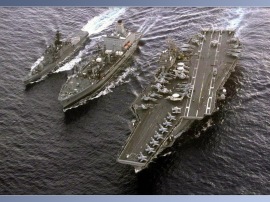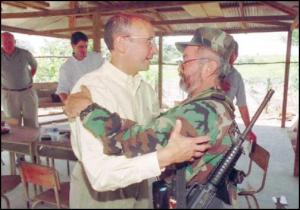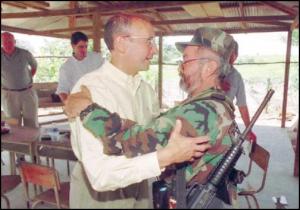The Military Presence to Maintain Neo-colonialism, Instability and Poverty
by Luis R. Miranda
The Real Agenda
May 1, 2010
By obtaining its independence, the colonies were preparing for what will inevitably come: the road to development and modernization. Many countries, was suggested, would be developed quickly; politically and economically. But these nations soon realized the sad reality. The dream would not be realized. Underdevelopment in Latin America found strong allies: the colonizers and their new social, economic and military agendas to ensure that those who had recently proclaimed its independence did not come out of their reach.
modernization. Many countries, was suggested, would be developed quickly; politically and economically. But these nations soon realized the sad reality. The dream would not be realized. Underdevelopment in Latin America found strong allies: the colonizers and their new social, economic and military agendas to ensure that those who had recently proclaimed its independence did not come out of their reach.
The Anglo-Saxon empire, mainly supported by a banking system without military or economic boundaries, swallowed the first semi-democratic bastions left in the planet now known as G7, and once these were controlled, it was a matter of time before the rest of the planet was well absorbed. Working through proxy governments like the United States, Canada, France, Spain, England, Italy, Australia, Colombia and more recently Iraq and Afghanistan, the empire used mainly three tools: the model of dependence, foreign aid and military hegemony .
With the dependency model, the empire was guaranteed, and still is today, that countries could not compete with their former owners. The unit includes illegal policies of protectionism, subsidies, establishing trading programs (FTAA, NAFTA, CAFTA)-to flood markets with cheap products, which together amount today to a perpetual trade imbalance tilted to favor bankers. This resulted in the fact that developing countries were never competitive in international markets and rather remained as subjects of the Anglo-Saxons to a greater degree. Developing countries continued to be territories where the globalist-controlled developed nations got their materials to perpetuate their development, while taking advantage of third world countries’ cheap labor to strengthen the corporatist system that has ruled the planet for nearly 200 years.
With financial aid, the corporatists inflicted a second blow that destroyed more dependent countries on the intentions of reaching the much desired development. When third world countries failed to develop, it just seemed like a great idea to borrow money to boost their economies towards development. However, the trojan horse with this new method was to keep the borrowing countries deep indebted to prevent their development. Most of the money from the World Bank, IMF and governments dominated by European bankers were given as loans. These loans are so attractive because of the time is provided for the repayment, but at the same time are brutal due to their high interest rates of 30%, 40%, etc., which makes it mathematically impossible to pay the accrued interests, let alone the capital. This effectively tied up the wings of any development momentum the third world had. Along with high-interest loans, the agreements contained in them also requires the adoption of austerity policies that further restrict governments from encouraging development; less money is spent on education, health, infrastructure, creation of projects that in turn generate jobs, etc.. Also attached to these limitations exists an obligation on the part of the debtors to pass on the debt to three or four generations to ensure that countries cannot allocate resources and/or plan ahead.
While the globalists plundered -and continue plundering resources-, developing are also the markets for selling finished products with added value, which transformed them not only in slaves, but also in mindless consumists molded through the Madison Avenue hollow propaganda. Then, a third strategy was implemented. The creation of military conflicts in the region by where corporatists simply collapsed large areas, almost the entire continent. This is very clear in Latin America today. The U.S. proxy government, led through the decades by various puppets of the Anglo-Saxon empire, flooded Latin America officially and unofficially, using his terrorist organizations like the Central Intelligence Agency (CIA). They used for operations in countries like Colombia, Mexico, Venezuela, Panama, Argentina and others to create resistance movements to destabilize the nations. This is one of the most common strategies used to create divisions among the people who end up eating away any country that shows a vestige of independence. The corporatists also ensure that only their pawns are elected presidents in these countries. Only those who attend the most famous universities in the U.S. and Europe, where they are indoctrinated or bribed, have a real chance to “steer” the destinies of their people.
The existence of common understandings through these governments ensures access to the country, establishing policies that assure more underdevelopment and the continued plundering of more resources. Today, the bankers who control the U.S. government has established military bases throughout Latin America. Along with this armies, the implementation of aid packages and coporatist policies, have also secured access to unlimited sources of energy, water and biodiversity. Some of the most influential are: the Plan Colombia, the FTAA, Plan Puebla Panama, and soon in 2010, the new carbon emissions agreement to be negotiated in Mexico under the command of the Prince of change, Barack Hussein Obama .
The military hegemony and the exercises that assure it are practiced in various countries by the Southern Command, which is an American paramilitary organization that for years has eaten away the independence and sovereignty of all countries in which it operates. Its main purpose is to train Latin American militaries to fight “terrorism”; that deluded idea created during the administration of George Bush and that is based on the assumption that Islamic extremists want to destroy the American dream and that if it was achieved, we would all suffer. Military exercises are conducted throughout Latin America, with recruits from countries like Brazil, Argentina, Peru, Paraguay, Chile and Bolivia. The most notorious example of these military exercises took place in 2001 when international troops invaded the Argentine territory of Salta to practice against suspected insurgents. New military bases are opened each year through the signing of new agreements for the establishment of more bases in Latin American and Caribbean territories. “The plan of economic and political domination, which has spearheaded the U.S. military dominance, goes also to monitor and control the dynamics of popular movements in the region or, as the Mexican teacher Ana Esther Cecena calls, deter, prevent the enemy from forming. “
The creation of military and naval bases is the daily bread for more and more Latinos. The facilities vary in names and sizes: the Tres Esquinas, Colombia; Iquitos, in Peru, Manta in Ecuador; Palmerola, Honduras; Comalapa, El Salvador, Queen Beatrix, on the island of Aruba, Liberia, Costa Rica. Resistance by many Latino citizens has had few positive results. In Brazil and Argentina, the banker controlled Washington, DC has developed a possible handover of the base of Alcantara, installed in Brazilian territory, and the possibility of installing a base in Misiones, on the triple border between Argentina, Paraguay and Brazil is almost a reality as well. The military hegemony not only consolidates the imperialist war power, but also enables the control of resources in the region. As bankers have done it in Asia, Latin America is also a source of precious materials. The 21st century colonialists who are the same for the past two centuries, have sacrificed the lives of millions of people in their desire to grab more territory. The United States in particular, has mechanisms of domination and overexploitation of the FTAA and NAFTA policies promoted by the IMF and World Bank, which are agencies of the Anglo-Saxon imperialist power. And why is there so much interest in what Latin America can provide? “Latin America and the Caribbean possesses 11 percent of the world oil reserves and produces nearly 15 percent of the oil extracted in the world,” cites the website visionesalternativas.com. “In addition, Latin America accounts for about 6 percent of natural gas reserves, large coal reserves – enough for about 288 years of exploitation – and abundant hydro-energy resources, estimated at over 20 per cent the global potential.
The Latin American natural wealth should be added to the fact that the globalists seek to implement more comprehensive policies in order to get more control over the population. Brazil, for example, has already adopted the RFID technology to impose property taxes on animals and in 2010 for the identification of individuals. Also in Brazil, the president recently signed a law that transferred huge tracts of land in the Amazon to the hands of the UN. A new “green police” also limits the development of projects and land use for food crops, thereby jeopardizing the supply of products to local and international markets. Mexico is currently the country with the continent’s most oppressive government where citizens are targeted by the military and paramilitaries, both groups are funded and controlled by the United States in order to ensure easy traffic of drugs to North America. Mexican cartels that do not obey the imperialists are exterminated and those who do pay their share of the goods and profits are free to murder anyone who opposes their reign. Just as in Afghanistan and Colombia, the U.S. army trained and armed Southern Command, controls the planting, harvesting and selling of tons of drugs that are then sent in the U.S., Canada, Europe, and of course in Latin America. The proceeds are then laundered through the big banks on Wall Street. The Anglo-Saxons have also hijacked the continent through the imposition of restrictions on commerce and military agreements between Latin American countries and other competitors such as China and Russia.
And what is the common denominator of imposing economic, political and military rules on the continent? The result is very clear. All you have to do is to review the overall state of the countries to realize that the objective of limiting or nullifying the development has been reached. According to the World Bank, the external debt only from the Mercosur countries increased from $185 million in 1990 to $325 million in 2005. The crime continues to increase in countries like Costa Rica, Mexico, Brazil, Colombia, Argentina, where gangs and drug cartels control populations on the outskirts of the metropolis, and remains highly stable in Guatemala, Honduras, Dominican Republic, Haiti and others. But perhaps the clearest result of policies imposed on Latin America is the underdevelopment in which all countries are maintained. No country in this block is considered to be developed after having proclaimed themselves independent nations for decades. Poverty in Latin America has gotten worse in many countries due to their internal and regional conflicts as well as corrupt governments that serve the globalists.
A recent study by ECLAC, an organization of the UN reveals that at least 182 million people live in poverty in Latin America, and the number of those living in extreme poverty reached 12.9 percent. The study reveals that the number of people regarded as poor increased due mainly to higher inflation and higher food prices. The poverty rate is divided into four groups. The first highlights countries whose levels are below 22% such as Argentina, Chile, Uruguay and Costa Rica, the second poorest group includes Brazil, Mexico, Panama and Venezuela, the third and even poorer has Colombia, Dominican Republic, Ecuador, El Salvador and Peru, and the fourth is composed by the worse off countries such as Bolivia, Guatemala, Honduras, Nicaragua and Paraguay.
Neo-colonialism does not allow developing countries to prosper, that’s a fact. The patent monopoly, control of natural resources and energy sources stop any progress. The use of military and paramilitary terrorism by globalists also stifles the nations and makes them victims of a system that is aimed at undermining the sovereignty and independence of any State. However, there is another fact that does not help in implementing development policies in Latin America. The legal and illegal choice of tyrants like Hugo Chávez in Venezuela, Fidel Castro in Cuba, Daniel Ortega in Nicaragua, and puppets like Oscar Arias, Ernesto Cedillo, Luis Inacio da Silva, Kristina Fernandez, Felipe Calderón, Alvaro Uribe and many others, contributes to all countries in Latin America continued in the hands of the imperialists. The tyrants, restrict progress because of their thirst for power denies their people the real benefits of development. Venezuela and Cuba are hit daily with attacks on freedom of speech, assembly, property rights and others. The puppets also limit development because they follow directly and indirectly imposing on the continent the plans that seek to restrain their countries from developing at all costs. It is a deadly combination of corruption and selfishness.
We must remember that the Anglo-Saxon plan’s main objective is to increase their control over the rest of the planet, and thereby promote and impose their policies on the nations of Latin America and beyond by using their own governments or organizations such as Mercosur, the North American Union, the African Union, Asian Union and of course the UN, the European Union, the World Health Organization, the World Trade Organization. The only way to start the path to development is thus breaking any existing relationships with these organizations to which all countries subject their decisions.
No organization has power over any country. This power that seems so hard to break is only valid if people let it rule them. In Iceland for example, Congress is about to vote on a measure to not pay external debt incurred in with the World Bank and IMF which was created through their illegal schemes of development loans. In the U.S., member states have and continue to proclaim their independence from the federal government which is bound to them by the system of slavery of the globalists. In Europe, at least half of the countries question the installation of malicious scanners at airports under the pretext of terrorism. When we understand that we are free to do what our Constitution allows, and that this is the only document that governs each of our lands, is when we will hold the Anglo-Saxon imperialists at bay. Therefore, progress, independence and freedom are realistic and achievable goals that are will come when each of the citizens as individuals make the decision to educate themselves, to understand how to the globalists deceive them with names, ideologies, political parties, false choices and even with religious extremism to keep them as slaves. No individual, no ideology, no political party, no politician or religion is the solution to progress by itself. The solution begins with each one of us first as thinking individuals and groups of active citizens demanding their governments the results for which they were elected.

Sources for this article include but are not limited to the following:
United States Imperialism in Latin America
http://www.hartford-hwp.com/archives/40/index-dca.html
US Interventions in Latin America Since 1823
http://www.mindfully.org/Reform/2003/US-Interventions-1823.htm
Neocolonialism: a bibliography
http://science.jrank.org/pages/7920/Neocolonialism.html
U.S. Military Aid Before and After 9/11, Region Breakdown
http://projects.publicintegrity.org/militaryaid/regiondetail.aspx?REGION=Western Hemisphere
The Bush Effect: U.S. Military Involvement in Latin America Rises, Development and Humanitarian Aid Fall
http://www.commondreams.org/views05/1105-21.htm
Qué es el ALCA?
http://www.visionesalternativas.com/militarizacion/geoestrategia/alca.htm
El Plan Puebla Panama
http://www.visionesalternativas.com/militarizacion/geoestrategia/ppp.htm
El Plan Colombia
http://www.visionesalternativas.com/militarizacion/geoestrategia/pcolom.htm
La Triple Frontera
http://www.visionesalternativas.com/militarizacion/geoestrategia/3front.htm
US Navy Deploys Around Latin America
http://rinf.com/alt-news/war-terrorism/us-navy-deploys-around-latin-america/3375/
Honduras deal a boost for US influence in Latin America http://www.csmonitor.com/World/Americas/2009/1030/p06s19-woam.html
US Navy Re-establishes Fleet for Caribbean, Latin America http://rawstory.com/news/afp/US_Navy_re_establishes_fleet_for_Ca_04242008.html
US builds up its bases in oil-rich South America
http://www.independent.co.uk/news/world/americas/us-builds-up-its-bases-in-oilrich-south-america-1825398.html
US launches major military exercises in the Caribbean as a warning to Venezuela and Cuba
http://www.handsoffvenezuela.org/us_military_exercises_venezuela_cuba.htm







 modernization. Many countries, was suggested, would be developed quickly; politically and economically. But these nations soon realized the sad reality. The dream would not be realized. Underdevelopment in Latin America found strong allies: the colonizers and their new social, economic and military agendas to ensure that those who had recently proclaimed its independence did not come out of their reach.
modernization. Many countries, was suggested, would be developed quickly; politically and economically. But these nations soon realized the sad reality. The dream would not be realized. Underdevelopment in Latin America found strong allies: the colonizers and their new social, economic and military agendas to ensure that those who had recently proclaimed its independence did not come out of their reach.
